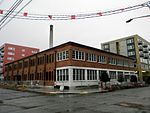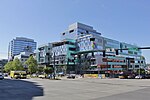South Lake Union, Seattle

South Lake Union (sometimes SLU) is a neighborhood in Seattle, Washington, so named because it is at the southern tip of Lake Union. The official boundaries of the City of Seattle Urban Center are Denny Way on the south, beyond which is Denny Triangle; Interstate 5 on the east, beyond which is Capitol Hill; Aurora Avenue N. (State Route 99) on the west, beyond which is Lower Queen Anne; and Galer Street, Lake Union, and E. Newton Place on the north, beyond which are Westlake and Eastlake, but like most Seattle neighborhoods, its precise boundaries are indeterminate. In particular Cornish College of the Arts and Vulcan Inc. properties such as 2200 and 2201 Westlake are officially in Denny Triangle for city planning and zoning purposes but often referred to as South Lake Union. The portion of South Lake Union east of Fairview Avenue N. is historically known as Cascade. Historic structures continue to stand in the Cascade neighborhood today. Its main thoroughfares are Valley and Mercer Streets (east- and westbound) and Dexter, 9th, Westlake, and Fairview Avenues N. and Eastlake Avenue E. (north- and southbound). The city addressed transportation issues by changing Mercer Street into a two-way, six-lane, tree-lined boulevard, with Valley Street becoming a two-way, pedestrian friendly road.
Excerpt from the Wikipedia article South Lake Union, Seattle (License: CC BY-SA 3.0, Authors, Images).South Lake Union, Seattle
Pontius Avenue North, Seattle Capitol Hill
Geographical coordinates (GPS) Address Website Nearby Places Show on map
Geographical coordinates (GPS)
| Latitude | Longitude |
|---|---|
| N 47.624444444444 ° | E -122.33166666667 ° |
Address
Carlton
Pontius Avenue North 603
98109 Seattle, Capitol Hill
Washington, United States
Open on Google Maps









